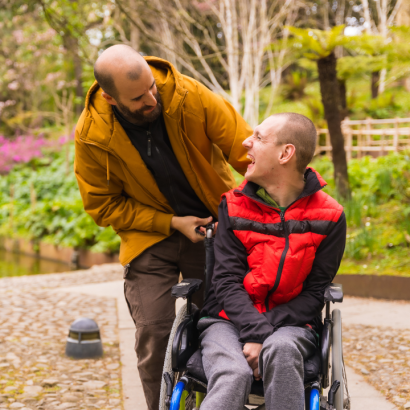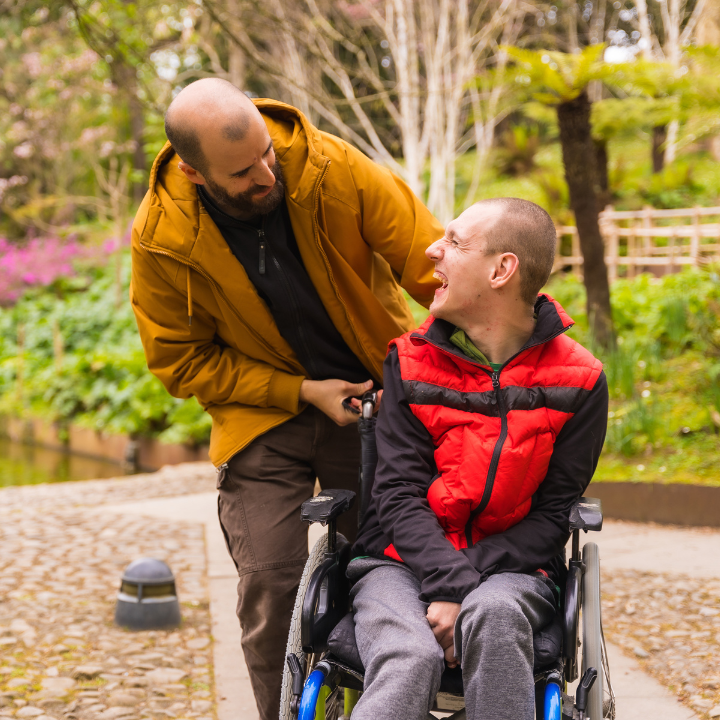Peter Gregory is an individualised service design practitioner. Peter talks to Mable’s Individualised Program Manager Libby Ellis about how a clinical role can contribute to individualised living.
Tell us about your work
For a long time now, I’ve been focussed on creating really individualised support with people who are regarded as complex for a variety of reasons. Typically, they or their families might have very negative reputations and the kind of language that gets used around them are things like ‘challenging behaviour’ or ‘difficult to house’. They are also people who often have restrictive practices in place.
Individualised supports are home and living opportunities that are tailored to the requirements of the person with disability. They are not constrained by inflexible rosters of care and policies and procedures that limit individuality. Individualised supports show that there are different options available than shared Supported Independent Living (SIL).
Examples of the outcomes of this kind of work are:
- Exploring sharing a home with a person without disability
- Engaging supporters in ways that aren’t standard rostered support. For example providing ‘live-in support’ in a rotating way such as 3 days on, 4 days off, 4 days on, 3 days off
- Tailoring NDIS Core Support around when the person requires assistance, not when it works for a service provider
- A tailored and negotiated Service Agreement.
How does great clinical practice fit in?
Through this work, I’ve seen the critical place clinicians like Occupational Therapists (OTs) and behaviour support practitioners can have in assisting people with disability achieve their version of home. They can have a transformative role when they believe there are possibilities for people beyond the traditional, 24/7 rostered support.
In this context, the great clinicians I have worked with are:
- Unpacking the dynamics around people
- Contributing to an hypothesis about what an ideal support framework might be. An example of this is ‘I would like to live with someone who doesn’t have a disability, and who might be able to assist me’
- Interpreting data into supporting evidence and support recommendations.
Can you tell us more about this task of ‘unpacking dynamics’?
What you’re doing in individualised living or ILO is breaking down the person’s current model and building an alternative in order to deliver safe and sustainable support where the person is active in their home and community life.
To do that with people who have a long experience of traditional services, requires a significant amount of analysis from really good behaviour support practitioners and therapists.
The good practice involves:
- Analysing the dynamics around why people have been given their labels
- Understanding their cues of distress in order to design support strategies that reduce or eliminate the use of restrictive practices
- Understanding the conditions that need to be present in a person’s life to ensure they can successfully participate in their home and community life.
This work is quite complicated because for many people, their cues of distress are always going to be there. With the right environment and the right approach to support, however, I have seen that those cues of distress don’t escalate, or the escalation can be minimised in severity or duration, or both.
Can you talk a bit about the task of assessment?
The task of assessment is to identify where the individual requires support from others, what needs to be paid for and what can be provided through other informal connections.
Too often, I have found that assessments are just interviews with parents or asking support workers to fill out forms and not involving the person with disability.
In making an assessment, the therapist must spend time with the person and the people who know them well. Without this, it’s impossible to get a nuanced understanding of the kind of support they need.
What’s the next step?
The next step is where clinicians look at the other factors that need to be considered to make this support successful. This is based on the lifestyle a person is wanting to move towards – for example ‘I would like to live with someone who doesn’t have a disability, and who might be able to assist me’.
These other factors could be:
- The layout of a home can either support or inhibit opportunities to move beyond having just a support worker
- How technology could be helpful
- How close the person needs to be to other services and community facilities
- The sensory environment around the person
- Having a functional communication strategy embedded in the person’s day-to-day support so they can exercise choice and control in their lives.
Examples
For example, with one man, his mother and I really believed that with the right support, he would be able to be alone, or with minimal supervision, for some times of his day and could get himself a really simple meal.
So you can start to see with this re-framing we’re not talking about standard rostered support anymore. We’re talking about the best location and how he can get the sort of monitoring that’s helpful and not intrusive.
We also started to look at what the purpose of his support worker would be. We said that it would assist him to develop that routine of being able to prepare his lunch in the morning, put it in the fridge and get it out and eat it. We said that their role was to introduce him to his community and to facilitate his presence and his participation in that community. That there was no reason for him to be immersed in segregated settings where his opportunities to experience mainstream community life and relationships were limited.
I have another example of someone with whom I went through this process together. Bruce was diagnosed with profound intellectual disability and autism. He lived at home with his mum. But she was unable to continue, so he moved to respite and then moved into supported independent living.
So, for Bruce, we were able to ensure that when the opportunity arose to move beyond supported independent living, he would be able to take his funding and move on without facing any barriers. We also ensured he moved into permanent accommodation in a community close to his family. Bruce’s mum was clear that she wanted a family like experience for him and to be close to his birth family. She didn’t see him living in a group home.
Eventually, Bruce’s mum moved to north Queensland. So, we decided that it was an opportunity for him to move into a lifeshare style of support (i.e. Sharing a home with someone who doesn’t have a disability). We did a whole lot of modelling around cost and developed some principles for what that would look like. For example, we agreed that if he was going to share his home with a person without disability, that person would have to be reimbursed at a level that they didn’t need another job for a liveable income, but that they would also have some down time.
We had to be very clear about what that person would be paid to do, and that living costs are separate. We understood that this would be like any other share house where the daily expenses for food, utilities, rent etc would be shared.
Eventually, we found someone who had her own house.
I did a lot of work in the background to put together a budget. This included what we would pay the support people, what Bruce would need in terms of capacity building support, engaging therapists to provide guidance around adjustments to the household, and developing Bruce’s communication skills. There was also a short term accommodation component built in for those periods when Bruce’s housemate needed some down time, as well as community participation contracted in from another provider. It was a big proposal, but less expensive than his share of the group home arrangement with far superior outcomes.
Today, Bruce still lives with his housemate, Mary. His support needs are complex, but it’s worked out really well for him. For both of them, the support relationship has gone beyond just support. Mary is his principal supporter and because his family is so involved, there is a lot of safeguarding. This is a household that is full of life, family, laughter and bucket loads of respect and love.
What advice would you give to people trying to secure the right NDIS resources to do this work?
- Be conscious of the end goal, clear about the stages to get there, and therefore what needs to be in the current plan.
- Make sure your funds are in a flexible form, so they should be at least Plan Managed (except those items where there is a statutory requirement for it to be Agency Managed).
- Be diligent about finding ways you can move beyond the use of restrictive practices and pay attention to how the person is assisted to make decisions.
- Reflect on your learnings. You’ll need to deal with the challenges of having a more direct relationship with your support workers and other supporters.
- Be conscious about how capacity gets built close to the person like a circle of support, or clarity about how decisions get made close to the individual like how they select their own support workers and raise concerns about them.
- Be clear about what decisions you are going to make, what decisions you want a provider to be making, and what are the decisions that you’re going to make together.

